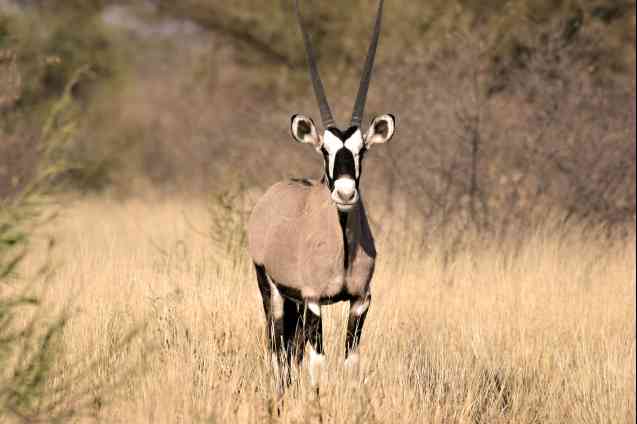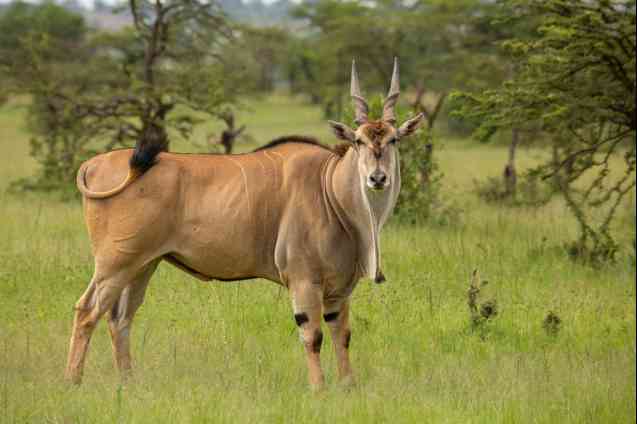Gemsbok vs Eland: African antelopes compared from hoof to horn and where to see the big bucks
Two of the biggest African antelope species, eland and gemsbok, are both attributed with mythical qualities, and strong connections to their past and habitat. Fossils found in Africa and France of the common eland date back 20 million years. The gemsbok is connected to ancient tales of the unicorn in the legends of Egypt. Both eland and gemsbok are striking in their elegance and proud stance, and are favourites amongst wildlife lovers on safari in Africa.
 Gemsbok with Distinctive facial markings and horns
Gemsbok with Distinctive facial markings and horns
Gemsbok in Africa
The handsome gemsbok, Oryx gazella, is the largest species of oryx. Often referred to as "the spirit of the desert" this African antelope is large and muscular, light brownish-grey to tan in colour. The dramatic black and white mask-like face markings, which extend in a black stripe along the bottom of the neck, side of the flanks, and into the top half of the legs, and their long black tails, make the gemsbok one of the most striking antelope species in Africa.
The gemsbok, a desert-adapted antelope, is found in the dry-arid regions of southern Africa. While males can grow to roughly 300kg / 660 lbs, females are smaller, both sexes have magnificent, straight, back-pointing rapier sharp horns. The horns grow up to 85 cm / 33 inches on average and are used for defence against rivals and against predators like lions. The female gemsbok’s horns tend to be more slender but longer. Unlike antlers, the gemsbok’s horns are a permanent feature that grows throughout their lifespan. They feed on desert grasses, thorny shrubs, roots, and tubers to supplement their water intake. Gemsbok can survive for days or even weeks without water and are the ultimate desert survivors.
This iconic African antelope is the national animal of Namibia and can be found on this desert country’s coat of arms. Oranjemund, a desert town at the mouth of the Orange River, is famous for its free-roaming gemsbok which nibbles on the grass in the parks and takes shelter amongst the town's shady trees.
Gemsbok are alert, fast, and feisty. Fortunately, despite being a popular trophy animal hunted for their horns, with around 373,000 animals, they are not considered endangered.
 Gemsbok vs Eland African antelopes
Gemsbok vs Eland African antelopes
|
Gemsbok Facts |
|---|
|
 Eland - The Largest Antelope in the World
Eland - The Largest Antelope in the World
Eland in Africa
The eland is the largest antelope species in the world, standing at over 2 meters / 6 ft 5 inches. Taurotragus oryx, the common eland is tawny with white torso stripes and can weigh more than a ton. Yet, for all their hefty weight, an adult can still leap over a 1.5-meter (or higher) fence from a standing start. Being so bulky, however, makes them the slowest antelope species.
Eland belongs to the spiral-horned antelope tribe, Tragelopini, along with kudu, nyala, and bushbuck. The females have slightly longer and thinner spiral horns and their colouring is usually shaded between ochre and tan. The bulls have shorter, thicker horns and are a darker shade that turns to a dark shade of bluish-grey that deepens as they age. All eland sport pendulous dewlaps (a flap of skin) under their necks, usually bigger in the males, which helps with thermoregulation in their hot and arid habitats. These ruminants can be found in grasslands, mountain, and woodland areas, and can survive without drinking water for days or even weeks.
The San people (formerly called bushmen) - the first people of southern Africa - often painted eland in their rock art as beautiful, refined cave paintings. According to their beliefs, the San tribe of the Karoo region believed the mythical eland was God's favourite animal and the first animal he ever created. An animal with great powers, the eland is associated with the sun in African cultures because of its light colouring. They are highly prized for their nutritious milk, large yield of tasty meat, and useful hides.
Eland antelopes are docile and often congregate in herds. Their sheer size makes them one of the sought-after African safari animals to see.
| Eland Facts |
|---|
|
 Eland drinking - Etosha, Namibia
Eland drinking - Etosha, Namibia
Similarities between Gemsbok and Eland
- They are both revered as ancient, mythical and spiritual animals with special powers.
- The females of both antelope species have longer and more slender horns than the males.
- Both species can survive for weeks without drinking water.
- Both of these African antelopes have bodies equipped with ingenious thermoregulation systems to keep them cool in severe heat.
- Both eland and gemsbok breed throughout the year.
Differences between Gemsbok and Eland
- Gemsbok are smaller, lighter, and faster, while eland are big, heavy and slow.
- Gemsbok thrive in dry arid environments while eland favours woodland, bush and savannah habitats with plenty of shrubs to browse on.
- Gemsbok herds have more females than males and average at about 14 individuals.
- Eland herds consist of an average of about 25 individuals.
- There are only 4 Oryx species. The eland family includes kudu, nyala, bushbuck and sitatunga.
Where to see Gemsbok Antelopes in Africa
Known as the “spirit of the desert”, the best place to see gemsbok is unsurprisingly in the arid areas of southern Africa. The best place to see gemsbok is in the Kalahari Desert in South Africa, Namibia, or Botswana.
Top African Parks for Sighting Gemsbok
- Makgadikgadi Pans - Botswana
- Central Kalahari National Park – Botswana
- Etosha National Park - Namibia
Where to see Eland Antelopes in Africa
Though widely distributed throughout southern Africa, eland are shy and reclusive animals. They favour semi-arid environments, savannahs, and open woodland.
Top Parks for Eland Sightings
- Kgalagadi Transfrontier Park – South Africa and Botswana
- De Hoop Nature Reserve – South Africa
- Etosha National Park – Namibia
- Mana Pools National Park - Zimbabwe
 Eland Bulls Fighting, Mana Pools - Zimbabwe
Eland Bulls Fighting, Mana Pools - Zimbabwe
Gemsbok vs Eland African Antelope
When on safari in Africa, the Big 5 animals are at the top of the list, but there is plenty more to see. Revered by the San people, the eland is the biggest antelope in the world, and its beauty, power, and grace make it an African safari must-see. The gemsbok, with its unique desert adaptations, is synonymous with the more arid regions of southern Africa. Both antelope, distinctive and remarkable, are integral to the African safari experience.
Sign up for the African Budget Safari Newsletter for monthly news, specials, and safari-related blogs.
If you liked this post, these trips cover similar ground…
- 3 Day Etosha Namibia Safari - Budget Camping Tour
- 4 Day Namibia Safari Adventure to Etosha & Swakopmund
- 7 Day Big Cats, Etosha & Desert Namibia Safari
- Budget Etosha National Park Lodge Safari
- 13 Day Botswana Camping Safari - Kalahari & Okavango Delta
- Botswana Camping Safari: Kalahari & Makgadikgadi Pans
- Kalahari & Okavango Delta Lodge Safari in Botswana











__small.jpeg)


